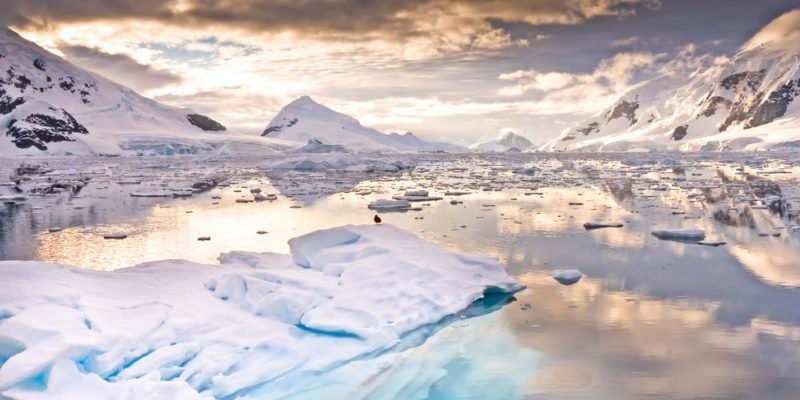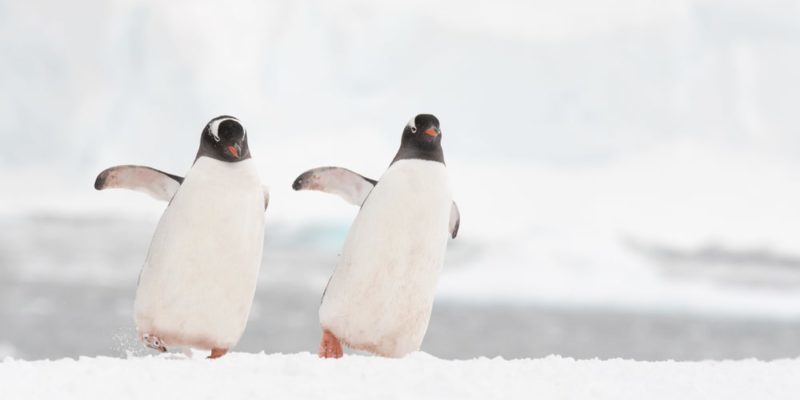The Antarctica It is a semicircular land mass that is located in the extreme south of the planet and is considered the sixth continent. It is about 4,500 kilometers in diameter and is surrounded by the Pacific, Atlantic and Indian Oceans.
Most of this continent is covered in an ice sheet and constitutes a polar desert characterized by low rainfall, its high altitude, very low temperatures and a dry and frozen soil with few nutrients. These adverse climatic conditions hinder the development of fauna and flora and human settlements.

Climate of Antarctica
Antarctica is the continent most windy and cold of the planet, with wind gusts of between 100 and 200 km / h and an average temperature of -50 ºC. It receives a very low level of precipitation, which varies according to the geographical area and is usually in the form of snow. Due to its extension and particular characteristics, the climate of Antarctica differs according to the geographical area.
- The downtown area. It is the central area of Antarctica and is considered the coldest part, with average temperatures below -50 ºC. It is desert due to its low rainfall, so there are almost no animal and plant species.
- The coastal area. It is the area that has contact with the sea and that has a lower altitude, moderate temperatures always higher than -30 ºC and some precipitation.
- The peninsula. It is the northernmost area of Antarctica and has the best climatic conditions. It presents some precipitations and the temperatures are somewhat warmer and humid than in other areas. In the summer there are usually temperatures between -2 and 5 ºC and in winter higher than -20 ºC.
Flora of Antarctica
Due to the hostile climate and low level of rainfall, the flora in Antarctica it is practically non-existent. Most of the continent is a frozen desert, so the permanent ice sheet that covers the ground prevents the proliferation of flora in this place. The plant species that inhabit Antarctica are usually found in the area of the peninsula or in coastal areas.
The antarctic grass and the Antarctic carnation are the only two plants that flourish in Antarctica. In addition, there are species of mosses, lichens, terrestrial algae and phytoplankton.
Fauna of Antarctica

Due to its icy climate, the terrestrial fauna It is rare in Antarctica and only consists of a few species of invertebrates such as mites and a single insect: the belgica antarctica (a species of flightless mosquito). However, there are a large number of individuals of marine species such as mammals, birds and fish.
The seas around Antarctica are home to sea leopards, sea lions, right whales, blue whales, humpback whales, seals, and a host of fish, such as ocellated icefish, Antarctic cod, Antarctic imp, nototenia, and fish. flashlights. In addition, there are echinoderms, such as starfish and sea suns; mollusks, such as the colossal squid, sea snails, and the Antarctic octopus; and crustaceans, such as krill, crab, and Antarctic shrimp.
The birds that inhabit Antarctica are penguins, albatrosses, petrels, the kelp gull, the Antarctic tern, and the Antarctic skipjack, among others. Some of the penguin species that live on the Antarctic continent are the emperor penguin, the chinstrap penguin, the Adelie penguin, and the gentoo penguin. They are birds that build colony settlements on the Antarctic soil during the stage of reproduction, incubation of eggs and development of young.
Human settlements in Antarctica
In Antarctica there are bases of different nationalities in which human communities live, permanently or during the summer, and carry out scientific research. Many of them are on the islands and on the Antarctic Peninsula.
Some of the most populated bases in Antarctica are the McMurdo base in the United States, the Marambio base in Argentina, the Rothera base in the United Kingdom and the Amundsen-Scott base in the United States.
The international relations Among the countries based in Antarctica, they are regulated by the Antarctic Treaty, which establishes the demilitarization of the area and protocols for the conservation of the natural environment of this continent.
